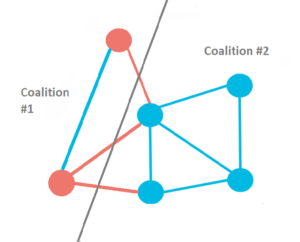Introduction
Though it is inevitable for individuals to hold a wide variety of beliefs, in recent years, many have become concerned about the growing prevalence of various potentially harmful beliefs. such as anti-vaccination and other such beliefs that oppose findings from mainstream science. As a result, attempts have been made to educate people on these scientific matters, but it remains unclear how effective such attempts are.
Is it possible, then, to use networks to predict how likely it is for an individual’s beliefs to change? If you’re familiar with the uses of network science, such as examples we’ve seen in this course, there are a couple approaches that might come to mind at first. You might think of looking at an individual’s social network, or the network of information they’re exposed to. However, the study conducted in the paper Using a cognitive network model of moral and social beliefs to explain belief change by Jonas Dalege and Tamara van der Does takes a more internal approach.
The Network Model
This study uses a network model with nodes representing various beliefs, with positive or negative ties between the nodes representing the positive or negative correlation between them. These ties are either strong or weak ties, depending on the strength of this correlation. For example, when a person believes medical science is untrustworthy, they are very likely to also think vaccines are untrustworthy. So these two belief nodes would have a positive strong tie between them. This should sound pretty familiar so far, right? However, unlike the typical network model, this model introduces a new feature – node ‘states’, with a positive and a negative state. So there might be a node ‘vaccines are trustworthy’, with a positive state if an individual agrees with the belief, and a negative state if they disagree. So while the base network is the same for all participants in the study, the states of the nodes vary from person to person.
The study hypothesizes that individuals whose belief network shows higher ‘dissonance’ are more likely to experience belief change, as their belief networks will evolve towards a lower dissonance state. This is attempting to translate the concept of ‘cognitive dissonance’ into a ‘network dissonance’, where a network is more ‘dissonant’ if the states of the nodes are more inconsistent with the ties between them. For example, if two nodes have a strong positive tie between them, they are consistent if both nodes have the same state, and have no dissonance. Conversely, if two nodes have a strong negative tie between them, they are consistent if both nodes have different states. Also, inconsistency between two nodes with a strong tie between them have a higher dissonance than inconsistency between two nodes with a weak tie between them. The overall dissonance of the network can therefore be computed by summing up the dissonance values for every pair of connected nodes. A diagram illustrating this can be seen in the paper, and is shown below:

Unfamiliar Yet Familiar?
This network model may seem foreign due to its differences with the model we’ve seen in class – but wait! If you look at it in another way, it may start to look a lot more familiar. Looking back at Balance Theorem, we can see that in a balanced state, the network will form two global coalitions, where nodes in the same coalition will have positive ties between them, and nodes in different coalitions will have negative ties between them. Suppose we now let all nodes in one coalition have positive ‘states’, while all nodes in the other coalition have negative ‘states’. Based on the definition above, this is exactly the representation of a network with no dissonance.

So it’s possible to consider networks with higher dissonance, i.e. further away from this ‘no dissonance’ state, as more ‘unbalanced’. As a result, the hypothesis that high dissonance networks are more likely to undergo belief change to enter a lower dissonance state feels a lot more intuitive – the network would be evolving towards a more ‘balanced’ state.
Conclusions
In the end, the study found that when prompted to think about their beliefs, participants’ ‘belief graph’ did in fact tend to evolve to one with lower dissonance. However, whether certain nodes were negative or positive was more influenced by initial beliefs than the content of the ‘interventions’, i.e. whether network (a) evolved towards (c) or (d) from the very first diagram depends on the initial states in network (a).
Considering that which coalition of the two has positive states has no effect on the ‘balance’ of the structure discussed earlier, in combination with the idea of evolving towards the ideal balanced state, could this maybe be the result of favoring whichever ‘balanced’ state takes the least belief changes to reach? In other words, is the network achieving a ‘balanced structure’ prioritized over assimilating the content of the information they receive into their belief network, when prompted to reflect on their beliefs?
In the face of problems where the typical network model is insufficient, there may be many variations such as the model seen in this study. However, we can see that there are still connections between these alternate models and the base concepts we’ve seen so far. This may be helpful to keep in mind in the future, as we continue on our journey delving deeper into the world of applied network science.
References
Dalege, J., & van der Does, T. (2022). Using a cognitive network model of moral and social beliefs to explain belief change. Science Advances, 8(33). https://doi.org/10.1126/sciadv.abm0137